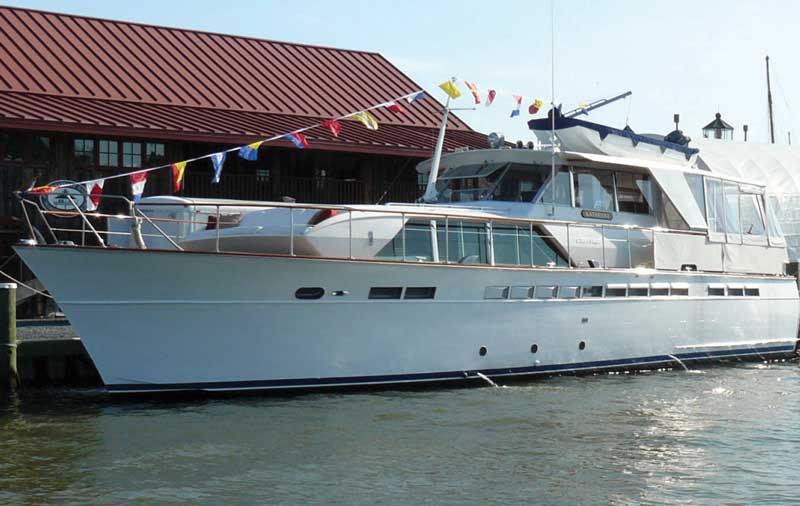The Chris-Craft Constellation, the yacht of my dreams as a youth... I can reflect back on sitting in my room after a full day at the New York Boat Show just drooling over this cruiser in the Chris-Craft catalog. Full color and all ready to go on a cruise. It was a diesel-powered model that I dreamed about… just like this one.

She is a Chris-Craft 57-foot Constellation, shown here in a Scott Walberg photo with two A/C systems running at the St. Michaels Antique and Classic Boat Show held at the Chesapeake Bay Maritime Museum in June of each year. The photo is from a prior year’s event.
She is a mahogany cruiser, and a sister ship to this model was the last wooden boat made by Chris-Craft. That boat was shipped on November 4, 1972. They made 262 of this model from 1963 to 1972. From then on it was either fiberglass or metal (if it was from the Roamer division). After 1977 when all Roamer production was ended, it was fiberglass cruisers only.
Chris-Craft is now owned by Winnebago Industries, Inc. (since June 4, 2018). The prior owner (seller) was Stellican, Ltd. who had owned Chris-Craft from 2001. The company has a brand heritage that dates back to 1874. They build boats in 2021 from 23 to 35 feet in length.
This model Chris-Craft is 57 feet LOA with a beam of 15 feet. She weighs about 24-25 tons. She is batten-seamed double planked mahogany in the carvel planking style. The bottom is double one and a half-inch planks with the rest of the hull being double seven eighths-inch planks. Primary framing is one and a half by three and a fourth inches on 24-inch centers with intermediate frames of one and a fourth inches by two inches, also on 24-inch centers. Thus, the frame spacing is every 12 inches.
The deckhouse roof and structure plus the pilothouse are made of fiberglass. Chris-Craft started using fiberglass in the mid-1950s for various parts and some cabin tops for their cabin cruisers and speedboats. The fin on the very stunning 1955 Cobra 21-footer was fiberglass. They used it in other boats, but this boat model is the best recognized.
While there were engine choices, over the years most of the yachts were powered by twin 8V71N GM diesels. These were in the 300-hp each range. Gas engines for the river and lake-based cruisers were also listed on the price sheets when the yachts were ordered. These boats often cruise at 11-12 knots at 1400-1500 RPMs with the GM diesels.
There is a forward stateroom with upper and lower berths with a separate head at the front of the accommodations plan. Next is the fully equipped galley to starboard with a convertible U-shaped dinette to port.
Up a half set of stairs is an expansive main salon with a less-than-full headroom engine room under it. See the three small portholes for the engine space in the photo. The generator is also in this space.
Aft and down the stairs there are a convertible couch and a guest stateroom, as well as the master stateroom. Both offer twin beds and a head. Dresser drawers are built-in within each. One feels a sense of spaciousness in the master, but not the guest areas.
On deck at the support panel are wing doors and with the enclosure keep the breeze and weather off the aft sitting area. Spacious side decks lead to the bow area were there is room for deck chairs in addition to the built-in seating at the front of the deckhouse.
The Cruising the Chesapeake June 18-20 ACBS Antique and Classic Boat Festival with its Arts at Navy Point of maritime juried artists and fine marine craftsmen is a wonderful, full festival and classic boat show. There are boat rides and seminars on June 18 and 19. The awards luncheon (separate fee) is on June 20, which is Sunday, Father’s Day. Boats for sale are offered all three days.
The 100 boats in the show range from runabouts to yachts with race boats, skiffs, launches, hydroplanes and utilities also there, in slips in the water and on the land of the 17 acres of the Chesapeake Bay Maritime Museum (CBMM).
By Chris "Seabuddy" Brown